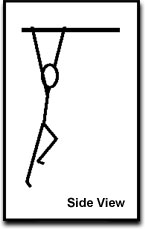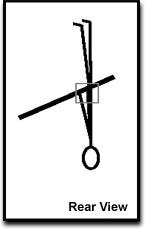The Swing
|
Article
By: Brian Yokoyama,
Mt.
San Antonio College (Mt. SAC)
|
The swing
(delay and rockback), is the phase which comes directly after
the takeoff (plant) and precedes the flyaway (extension). It is
responsible for transferring horizontal energy into vertical energy
as well as generating additional horizontal and vertical energy.
A the efficiency of the swing increases, a greater amount of energy
is transferred to vertical energy, allowing for the use of stiffer
poles and increased clearances.
The most
efficient technique occurs through an extended leg (single or
double) swing (Fraley, 1995 / Hirota, 1993). An extended leg throughout
the swing will enable the vaulter to load additional energy
into the pole.
| Key
points of an efficient swing include: |
| Proper
Takeoff |
Sets
up the vaulter in the proper position to swing fast and efficiently.
(Trail leg behind) |
| High
Bar Position |
Arms
must reach an extended position directly over head. Vaulters/Gymnasts
must reach this position in order to swing around the pole/highbar. |
| Extended
Arms |
Both
arms should be extended and rowing forward to the hips, allowing
stored energy to be kept in the pole. Any collapse of the
arms will release energy from the pole. |
| Extended
Leg |
Single
or double leg swing will generate horizontal and vertical
velocity. |
| Shoulder
Rotation |
Rotation
of the body should mostly be through the shoulder and not
the waist. |
| Fast
Swing |
The
shorter the time between the hang position (fig. 2) and vertical
perpendicular position (fig. 4), the less drag on the pole.
For example. a pole that is held parallel to the ground requires
a greater force to hold, than a pole held perpendicular to
the ground. |
The following
diagram demonstrates a four phase model of the swing (the model
is a right handed vaulter).

Takeoff Phase
(Fig. 1) |

Highbar Phase
(Fig. 2) |

Swing Phase
(Fig. 3) |

Vertical Phase
(Fig. 4) |
1.
Arms/body are fully extended and creating a 90 degree angle
with the pole.
2. Both arms are extended
and equally placing pressure into the pole.
3. All force is placed
upward into the pole (arrows) |
1.
Both arms are extended directly overhead.
2. Both arms are placing
equal pressure upward into the pole.
3. Trail leg is behind
allowing for a faster swing.
4. Lead leg is in a well
balanced position. |
1.
Both arms are extended and rowing forward, keeping energy
in the pole.
2. Trail leg is straight
(generates additional horizontal and vertical energy).
3. Rotation of the body
occurring at the shoulders. |
1.
Vaulter is in a rigid extended position.
2. Both arms are extended
(keeping energy in the pole) and actively moving throughout
the swing.
3. Right arm is rowing
toward hip (light box).
4. Lead leg extends. |
![]()



